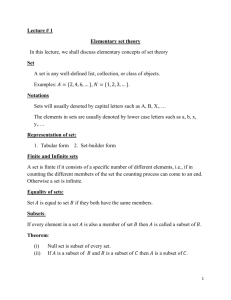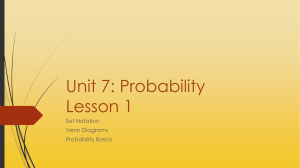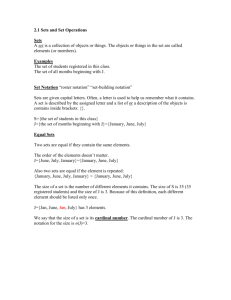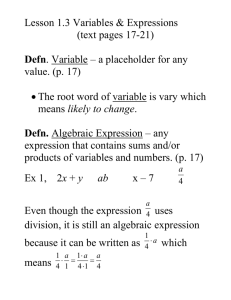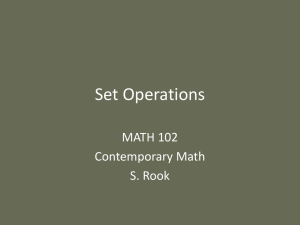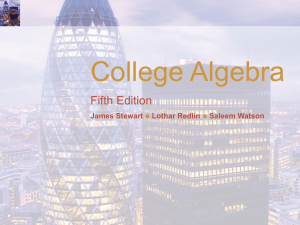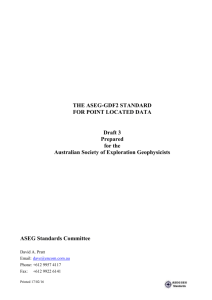Properties of Set Operations
advertisement
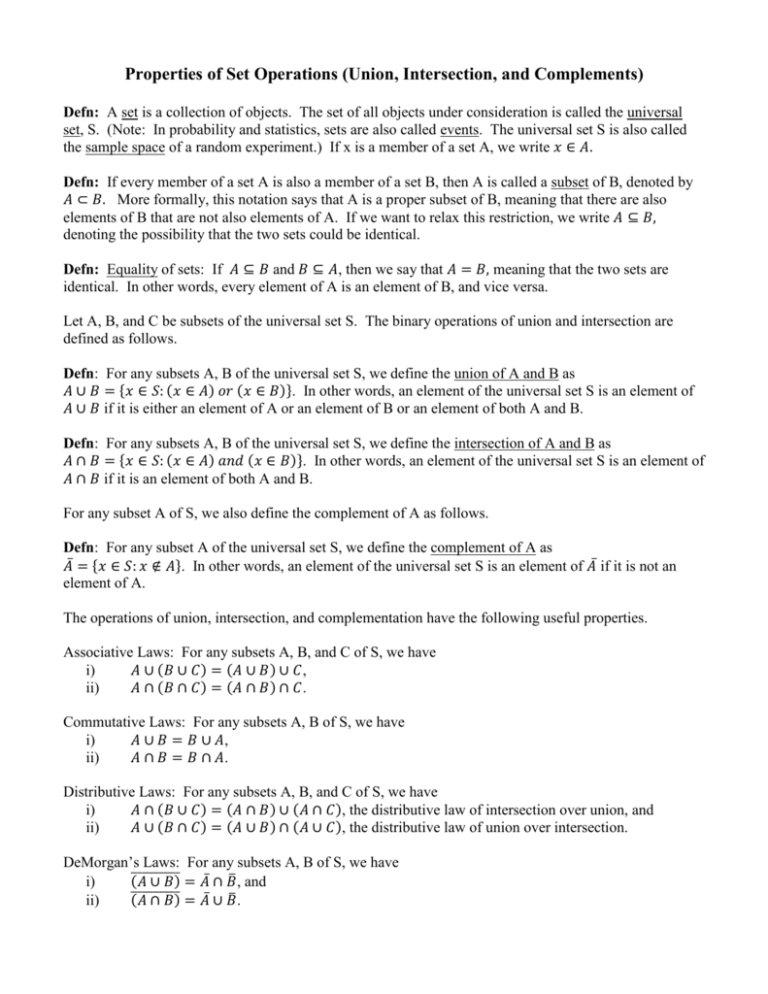
Properties of Set Operations (Union, Intersection, and Complements)
Defn: A set is a collection of objects. The set of all objects under consideration is called the universal
set, S. (Note: In probability and statistics, sets are also called events. The universal set S is also called
the sample space of a random experiment.) If x is a member of a set A, we write 𝑥 ∈ 𝐴.
Defn: If every member of a set A is also a member of a set B, then A is called a subset of B, denoted by
𝐴 ⊂ 𝐵. More formally, this notation says that A is a proper subset of B, meaning that there are also
elements of B that are not also elements of A. If we want to relax this restriction, we write 𝐴 ⊆ 𝐵,
denoting the possibility that the two sets could be identical.
Defn: Equality of sets: If 𝐴 ⊆ 𝐵 and 𝐵 ⊆ 𝐴, then we say that 𝐴 = 𝐵, meaning that the two sets are
identical. In other words, every element of A is an element of B, and vice versa.
Let A, B, and C be subsets of the universal set S. The binary operations of union and intersection are
defined as follows.
Defn: For any subsets A, B of the universal set S, we define the union of A and B as
𝐴 ∪ 𝐵 = {𝑥 ∈ 𝑆: (𝑥 ∈ 𝐴) 𝑜𝑟 (𝑥 ∈ 𝐵)}. In other words, an element of the universal set S is an element of
𝐴 ∪ 𝐵 if it is either an element of A or an element of B or an element of both A and B.
Defn: For any subsets A, B of the universal set S, we define the intersection of A and B as
𝐴 ∩ 𝐵 = {𝑥 ∈ 𝑆: (𝑥 ∈ 𝐴) 𝑎𝑛𝑑 (𝑥 ∈ 𝐵)}. In other words, an element of the universal set S is an element of
𝐴 ∩ 𝐵 if it is an element of both A and B.
For any subset A of S, we also define the complement of A as follows.
Defn: For any subset A of the universal set S, we define the complement of A as
𝐴̅ = {𝑥 ∈ 𝑆: 𝑥 ∉ 𝐴}. In other words, an element of the universal set S is an element of 𝐴̅ if it is not an
element of A.
The operations of union, intersection, and complementation have the following useful properties.
Associative Laws: For any subsets A, B, and C of S, we have
i)
𝐴 ∪ (𝐵 ∪ 𝐶) = (𝐴 ∪ 𝐵) ∪ 𝐶,
ii)
𝐴 ∩ (𝐵 ∩ 𝐶) = (𝐴 ∩ 𝐵) ∩ 𝐶.
Commutative Laws: For any subsets A, B of S, we have
i)
𝐴 ∪ 𝐵 = 𝐵 ∪ 𝐴,
ii)
𝐴 ∩ 𝐵 = 𝐵 ∩ 𝐴.
Distributive Laws: For any subsets A, B, and C of S, we have
i)
𝐴 ∩ (𝐵 ∪ 𝐶) = (𝐴 ∩ 𝐵) ∪ (𝐴 ∩ 𝐶), the distributive law of intersection over union, and
ii)
𝐴 ∪ (𝐵 ∩ 𝐶) = (𝐴 ∪ 𝐵) ∩ (𝐴 ∪ 𝐶), the distributive law of union over intersection.
DeMorgan’s Laws: For any subsets A, B of S, we have
̅̅̅̅̅̅̅̅̅̅
(𝐴 ∪ 𝐵) = 𝐴̅ ∩ 𝐵̅ , and
i)
̅̅̅̅̅̅̅̅̅̅
(𝐴 ∩ 𝐵) = 𝐴̅ ∪ 𝐵̅ .
ii)
The first says that the complement of the union of two sets is the intersection of their individual
complements. The second says that the complement of the intersection of two sets is the union of
their individual complements.
Identity Elements: For any subset A of S, we have
i)
𝐴 ∪ ∅ = 𝐴, and
ii)
𝐴 ∩ 𝑆 = 𝐴.
These laws may be proved using the definitions of union, intersection and complement by considering
any element x of the set given on each side of the equality and showing that it must also be an element of
the set on the other side of the equality.


